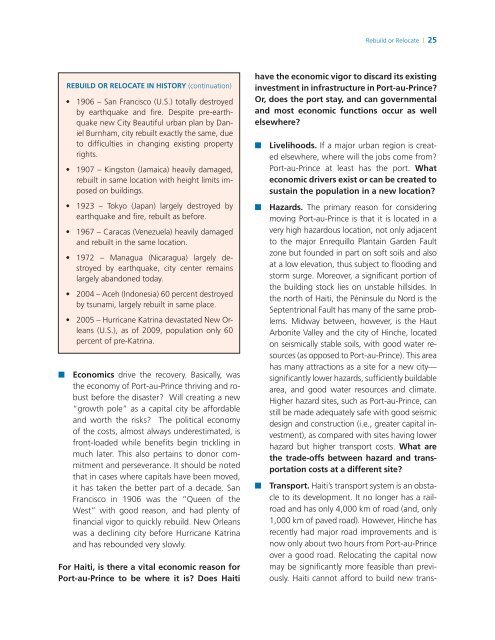Haiti Earthquake Reconstruction Knowledge Notes from ... - GFDRR
Haiti Earthquake Reconstruction Knowledge Notes from ... - GFDRR
Haiti Earthquake Reconstruction Knowledge Notes from ... - GFDRR
You also want an ePaper? Increase the reach of your titles
YUMPU automatically turns print PDFs into web optimized ePapers that Google loves.
Rebuild or Relocate | 25<br />
Rebuild or Relocate in History (continuation)<br />
• 1906 – San Francisco (U.S.) totally destroyed<br />
by earthquake and fire. Despite pre-earthquake<br />
new City Beautiful urban plan by Daniel<br />
Burnham, city rebuilt exactly the same, due<br />
to difficulties in changing existing property<br />
rights.<br />
• 1907 – Kingston (Jamaica) heavily damaged,<br />
rebuilt in same location with height limits imposed<br />
on buildings.<br />
• 1923 – Tokyo (Japan) largely destroyed by<br />
earthquake and fire, rebuilt as before.<br />
• 1967 – Caracas (Venezuela) heavily damaged<br />
and rebuilt in the same location.<br />
• 1972 – Managua (Nicaragua) largely destroyed<br />
by earthquake, city center remains<br />
largely abandoned today.<br />
• 2004 – Aceh (Indonesia) 60 percent destroyed<br />
by tsunami, largely rebuilt in same place.<br />
• 2005 – Hurricane Katrina devastated New Orleans<br />
(U.S.), as of 2009, population only 60<br />
percent of pre-Katrina.<br />
■ ■ Economics drive the recovery. Basically, was<br />
the economy of Port-au-Prince thriving and robust<br />
before the disaster? Will creating a new<br />
“growth pole” as a capital city be affordable<br />
and worth the risks? The political economy<br />
of the costs, almost always underestimated, is<br />
front-loaded while benefits begin trickling in<br />
much later. This also pertains to donor commitment<br />
and perseverance. It should be noted<br />
that in cases where capitals have been moved,<br />
it has taken the better part of a decade. San<br />
Francisco in 1906 was the “Queen of the<br />
West” with good reason, and had plenty of<br />
financial vigor to quickly rebuild. New Orleans<br />
was a declining city before Hurricane Katrina<br />
and has rebounded very slowly.<br />
For <strong>Haiti</strong>, is there a vital economic reason for<br />
Port-au-Prince to be where it is? Does <strong>Haiti</strong><br />
have the economic vigor to discard its existing<br />
investment in infrastructure in Port-au-Prince?<br />
Or, does the port stay, and can governmental<br />
and most economic functions occur as well<br />
elsewhere?<br />
■ ■ Livelihoods. If a major urban region is created<br />
elsewhere, where will the jobs come <strong>from</strong>?<br />
Port-au-Prince at least has the port. What<br />
economic drivers exist or can be created to<br />
sustain the population in a new location?<br />
■ ■ Hazards. The primary reason for considering<br />
moving Port-au-Prince is that it is located in a<br />
very high hazardous location, not only adjacent<br />
to the major Enrequillo Plantain Garden Fault<br />
zone but founded in part on soft soils and also<br />
at a low elevation, thus subject to flooding and<br />
storm surge. Moreover, a significant portion of<br />
the building stock lies on unstable hillsides. In<br />
the north of <strong>Haiti</strong>, the Péninsule du Nord is the<br />
Septentrional Fault has many of the same problems.<br />
Midway between, however, is the Haut<br />
Arbonite Valley and the city of Hinche, located<br />
on seismically stable soils, with good water resources<br />
(as opposed to Port-au-Prince). This area<br />
has many attractions as a site for a new city—<br />
significantly lower hazards, sufficiently buildable<br />
area, and good water resources and climate.<br />
Higher hazard sites, such as Port-au-Prince, can<br />
still be made adequately safe with good seismic<br />
design and construction (i.e., greater capital investment),<br />
as compared with sites having lower<br />
hazard but higher transport costs. What are<br />
the trade-offs between hazard and transportation<br />
costs at a different site?<br />
■■<br />
Transport. <strong>Haiti</strong>’s transport system is an obstacle<br />
to its development. It no longer has a railroad<br />
and has only 4,000 km of road (and, only<br />
1,000 km of paved road). However, Hinche has<br />
recently had major road improvements and is<br />
now only about two hours <strong>from</strong> Port-au-Prince<br />
over a good road. Relocating the capital now<br />
may be significantly more feasible than previously.<br />
<strong>Haiti</strong> cannot afford to build new trans-

















